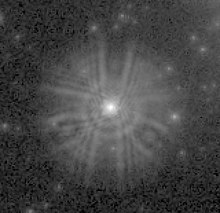First light
In astronomy, the first light is the moment when light from a star falls for the first time on the mirror or the lens of a new telescope . This applies not only to the telescope itself, but also to the instruments connected to it, which are each assigned their own first light. Analogously, one speaks of the first light of a radio telescope when it receives radio waves for the first time and the receivers in different wave ranges can each have their own first light.
When starting up lasers , the term is used for the first light generated before the laser is operated at its maximum power.
The term is often used in the English version first light in the German-speaking world .
astronomy
Usually, first light images are not of great scientific importance and are of lower quality than later images because the telescope or instrument has not yet been fully adjusted . Often well-known or spectacular astronomical objects with a high recognition value are selected for the first image. In principle, the first light is only the first successful function test for the entire system and proves that the technology works.
The moment of the "first light" is an exciting and important event for the designers and builders of a new telescope, but also for larger parts of the astronomical world. In particular, the first light of a new type of telescope - such as that of the Large Binocular Telescope in 2007 - is mostly of worldwide interest.
